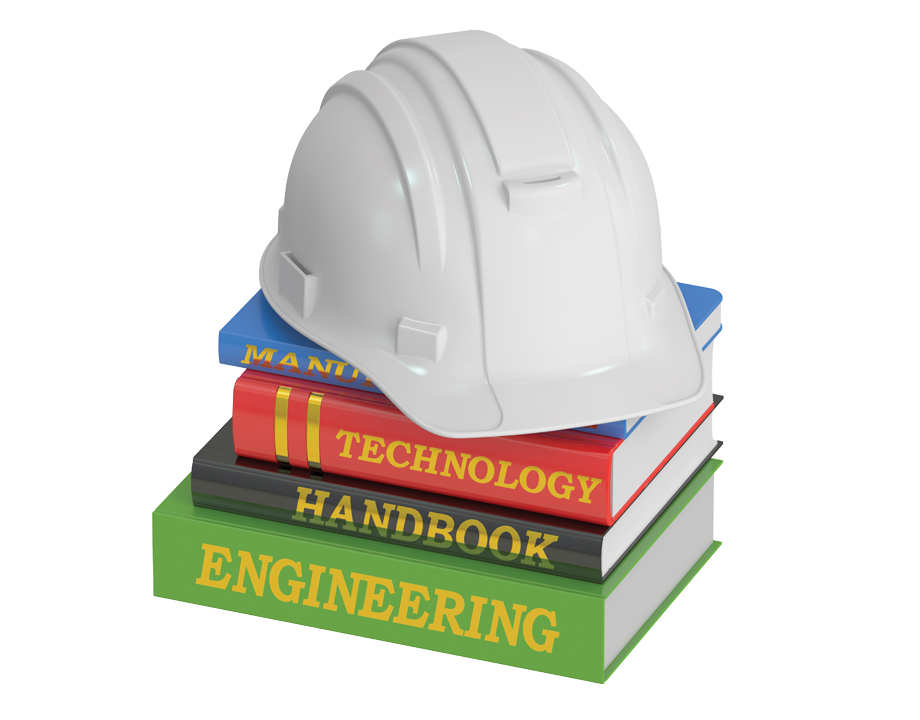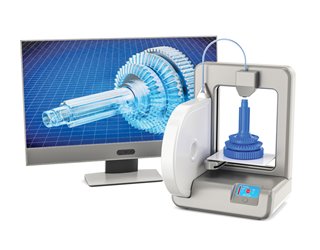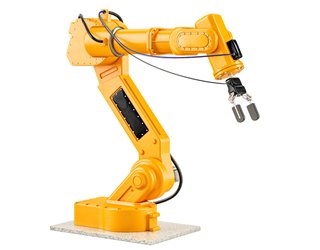Training the Future Engineering Workforce
Training the Future Engineering Workforce


Industry and academia must collaborate on programs that provide students with the skills they want—and need—to prosper in tomorrow’s technology workplace.
It is an exciting time in the world of manufacturing. Industry is rapidly changing and adopting technologies, automation, and digitization as part of a new industrial revolution: Industry 4.0. Across the globe, technologies and processes that seemed impossible just a decade ago—artificial intelligence, machine learning, generative design, and digital twins, to name just a few—are now seen as the basis for growth in the coming decade. These emerging technologies will help companies meet new demands from their customers.
Through digital transformation and wholesale business innovation, Industry 4.0 will no doubt bring with it new opportunities to create the most technologically advanced, sustainable, and efficient products that the world has ever known.
If only job seekers showed the same kind of excitement for manufacturing.
There are record numbers of unfilled jobs across the globe, with many organizations predicting even greater shortfalls in the amount of skilled labor before the end of the decade. According to the Manufacturing Institute, the manufacturing skills gap in the U.S. could result in 2.1 million unfilled jobs by 2030.
The new technologies and processes of Industry 4.0 may help companies address skill gaps in their workforces, at least in the short term, but at this pivotal moment, many industry leaders are wondering: What will the industry and workforce look like in another 10 years? And what can be done to reduce the disparity between the needs of businesses and the skills available in the labor market?
To help address uncertainty about the future of work and provide some insight, Autodesk and the American Society of Mechanical Engineers collaborated on a comprehensive research project that included an academic literature review, in-depth phone interviews, and surveys of respondents in the U.S., Canada, and U.K. The resulting white paper, Future of Manufacturing, was released this fall and offers perspectives from both industry and academia that help identify the future workflows and skills needed, with a focus on mechanical engineers, manufacturing engineers, and CNC machinist roles over the next decade.
One of the key takeaways was the need for educators—spanning secondary to higher education, vocational, and technical training—to better prepare students for emerging technologies while still teaching foundational concepts and theories, all while meeting accreditation standards.
Discover the Benefits of ASME Membership
How can educators accomplish all of this in a classroom and why is it so important? I’ve personally been in this position, asking myself and my colleagues this exact question. As a former lecturer in the School of Engineering at the University of Warwick, I have experienced firsthand the challenges of incorporating new concepts and technology into existing teaching programs. What I found—and what our research backs up—is that it’s absolutely necessary for academia and industry to collaborate.
The research we conducted to produce Future of Manufacturing told us that as Industry 4.0 adoption progresses, the convergence and digital transformation of job roles across the manufacturing spectrum is becoming increasingly evident. As this transformation unfolds, mechanical engineers, manufacturing engineers, and CNC machinists will work together more closely, leveraging cloud-based software and fully integrated hardware solutions to design and manufacture the products of the future. As the need for closer and quicker collaboration intensifies, the traditional boundaries between roles will blur and may even start to disappear.
These changes will fundamentally shift the job descriptions of many roles and continue to shape skill requirements at every level of the manufacturing process, requiring a new way of thinking about education and training the next generation. When I personally think about the future, I can foresee a time when mechanical and manufacturing engineers of the future may bear more than passing resemblance to the systems engineers, electrical engineers, software engineers, and data scientists of today.
While we may all have our own visions for the future of the industry, we must also know that we cannot do this work in silos. In order to build a well-rounded study, we spoke with a wide array of industry professionals and academic leaders to help gather substantial data that paints a more realistic image of where we are today and where we’re heading tomorrow.
From our research, we gained valuable insight into the anticipated changes in each of the three roles we looked at over the next five to 10 years.
Our research told us that mechanical engineers will continue to improve upon engineering designs and become more involved in manufacturing implementations and processing production data results to improve designs for manufacturability. This means they will need to have applied knowledge throughout the manufacturing process; no more “throwing it over the wall.” The survey showed 80 percent of academics agree that application of technologies like generative design will be a particularly important skillset for this role.
Workforce Blog: Engineering a More Sustainable Future
The research also showed that the manufacturing engineer position will become even more interdisciplinary as it blends skills with both mechanical engineers and CNC machinists. They will expand their focus from manufacturing processes to managing the overall production operations and analyzing globally distributed systems, including machining tools, robotic systems, and additive manufacturing facilities. Within industry, 72 percent of respondents believe human-robotic interaction will increase and 74 percent believe automation will increase for this role.
We also saw that CNC machinists’ roles will evolve dramatically, moving from being a CNC operator to an engineering technician who programs CNC machines. Over time, they will take on other manufacturing engineering functions.
Of all three roles, this one is expected to change the most. Machinists will need to develop new skills in artificial intelligence and machine learning for production, five-axis machines, additive manufacturing, and hybrid manufacturing. They will also be expected to collaborate more with engineering teams and be more involved with upstream processes including design, which will require greater knowledge of CAM software.
The research didn’t just tell us about technical skills. We also found that workers entering these roles will need to be proficient with “soft” skills such as problem solving, collaboration, and, of course, communication.
What does all this change occurring in the next decade mean for the education and training of a new workforce?
Among the research findings, there were specific indicators for actions to take, like a strong chorus of support for growing students’ design for manufacturing knowledge and skills. Some 90 percent of respondents believed teaching this skillset is one of the most impactful ways for academia to develop the future manufacturing workforce. Additionally, academics and industry professionals are looking toward the future with shared interest in emerging technologies like artificial intelligence, machine learning, and 3D printing. The research pointed to these emerging skills growing in importance and application over the next decade, and fortunately, we know these technologies are fascinating topics to students themselves.
While these insights are compelling, they also expose a delta between where the industry is heading and the current topics of academic curricula. And with business pressures driving manufacturing to adopt more Industry 4.0 technologies, it is critical for academia and industry to align on trends and requirements as soon as they can. Educators at every level are tasked with preparing students for emerging technologies while still teaching foundational concepts and theories, all while meeting accreditation standards. It’s a daunting task.
At the University of Warwick, I was responsible for curriculum development and teaching mechanical engineering and design, which means I not only had to build courses that incorporated new concepts and technology, but I had to do so while keeping the pre-existing skillset of the students in mind.
Students often enter these programs with little or no design and manufacturing knowledge and educators need to bring them up to speed as quickly as possible. This is no fault of the student but does require the training program to broaden its scope and start at a very foundational level to establish key fundamental skills before moving on to more advanced topics and workflows.
Back when I was building courses, one of my dilemmas was whether I should introduce advanced topics like generative design early on in a program or wait until later years. I came down on the side of exposing students to these technologies in their first few weeks to help them build comfort, and then slowly refining their skills over the duration of the program.
While our research focused on speaking with people from industry and academia, I think it’s also valuable to have a student perspective in mind. I reached out to some of my former students who went through traditional mechanical engineering programs to hear their thoughts on what gaps exist between academic programs and industry requirements.
More about the Engineerng Pipeline: Scholarships as Workforce Builders
“At times it felt like there was a lack of convergence to the skills I would actually need beyond university—instead it was heavily knowledge-based,” my former student, Elliott Griffiths, shared with me. “In my mind, it would be beneficial to deliver training in workflows instead of discretized delivery of content. Working with end-to-end applied workflows helps develop the skill to learn other skills, making you a lot more comfortable with new processes and applications, in my opinion.”
Elliott’s perspective provides valuable feedback on modern education programming and resonates with what we heard from so many other academics about the need for updating curricula with real-world skills.
While there will always be a need for the kind of specialization and research that can only blossom in universities, engineering education must focus on reducing the “time to talent,” that is, the speed at which schools can produce application-centered professionals. The research showed us that creating “industry-aware” curricula is going to be key in reducing the time to talent.
College-Level Education: Universities Respond to COVID
For this model to work, it is crucial that academia and industry collaborate. Too often there is a perception that academia and industry are at odds with their goals and requirements, and the topic of pushing academia more towards job-ready skills is hotly debated.
We should remember, however, that students are key stakeholders in these conversations. They enter engineering and technology programs with a goal to not just earn an education, but also to find a rewarding job at the end of their program.
Fortunately, our research suggests that academia and industry are each enthusiastic about working together. Across industry professionals and academics, all respondents agree on the need for business leaders to support the education sector with curriculum development. There is also shared interest in reducing time to talent by leveraging real-world contexts and hands-on experiences.
In addition to teaching new skills in the classroom, educators should also incorporate time for industry-recognized certifications for modern software, machines, and workflows. It may come as a surprise to some, but we learned that 86 percent of academics surveyed embrace less reliance on traditional degrees and welcome more specialized certifications developed in partnership with industry.
Using project-based, role-aligned learning pathways also embraces students’ desire to be immersed in meaningful content and target specific skills that will be required in their future jobs. Role-aligned pathways are a great way to target specific skill sets and competencies in new or existing programs and it’s something Autodesk has been working on for a while. To give you an example, pathways like Autodesk’s Fusion 360 CAM for 2.5 Axis Milling certification program enables students to follow a self-paced, curated playlist of videos, quizzes, and challenge assignments designed specifically for the CNC machinist role.
Certifications are also going to be increasingly helpful in ensuring students learn foundational skills but also demonstrate their competency to future employers.
In addition, embracing certifications allows educators to avoid forcing students to “log seat time” to demonstrate proficiency. Verifying competencies with industry-validated certifications allows students to make progress on building new skills once they have reached a proven level of expertise.
This approach inherently removes down time from training programs and creates a more personalized learning experience.
Further, 84 percent of all survey respondents believe employers and academia should partner on new types of certification programs based on employer needs, and 91 percent want new opportunities for long-term internships and co-op programs.
Reaching New Students: Lifting Barriers for Young BIPOC Engineers
Closer links between education and industry are going to be vital to ensuring that the talent pipeline is robust and able to rise to the challenges of the future, both seen and unseen. It is undeniable that Industry 4.0 will transform manufacturing as we know it today. We also know that education will have to undergo its own changes to keep pace and prepare students with the necessary skills for future roles in manufacturing.
The research we conducted for Future of Manufacturing has told us that there is shared interest in this transformation, as both sides can see the benefits. By creating an education ecosystem that closely partners with industry and embraces new Industry 4.0 technologies, we can reimagine workforce development and engineering programs to build a better tomorrow.
Simon Leigh is Senior Manager Global Education Strategy at Autodesk. He is based in Coventry, England. You can download a copy of the white paper, Future of Manufacturing, from ASME.org.
Through digital transformation and wholesale business innovation, Industry 4.0 will no doubt bring with it new opportunities to create the most technologically advanced, sustainable, and efficient products that the world has ever known.
If only job seekers showed the same kind of excitement for manufacturing.
There are record numbers of unfilled jobs across the globe, with many organizations predicting even greater shortfalls in the amount of skilled labor before the end of the decade. According to the Manufacturing Institute, the manufacturing skills gap in the U.S. could result in 2.1 million unfilled jobs by 2030.
The new technologies and processes of Industry 4.0 may help companies address skill gaps in their workforces, at least in the short term, but at this pivotal moment, many industry leaders are wondering: What will the industry and workforce look like in another 10 years? And what can be done to reduce the disparity between the needs of businesses and the skills available in the labor market?
To help address uncertainty about the future of work and provide some insight, Autodesk and the American Society of Mechanical Engineers collaborated on a comprehensive research project that included an academic literature review, in-depth phone interviews, and surveys of respondents in the U.S., Canada, and U.K. The resulting white paper, Future of Manufacturing, was released this fall and offers perspectives from both industry and academia that help identify the future workflows and skills needed, with a focus on mechanical engineers, manufacturing engineers, and CNC machinist roles over the next decade.
One of the key takeaways was the need for educators—spanning secondary to higher education, vocational, and technical training—to better prepare students for emerging technologies while still teaching foundational concepts and theories, all while meeting accreditation standards.
Discover the Benefits of ASME Membership
How can educators accomplish all of this in a classroom and why is it so important? I’ve personally been in this position, asking myself and my colleagues this exact question. As a former lecturer in the School of Engineering at the University of Warwick, I have experienced firsthand the challenges of incorporating new concepts and technology into existing teaching programs. What I found—and what our research backs up—is that it’s absolutely necessary for academia and industry to collaborate.
Convergence
The research we conducted to produce Future of Manufacturing told us that as Industry 4.0 adoption progresses, the convergence and digital transformation of job roles across the manufacturing spectrum is becoming increasingly evident. As this transformation unfolds, mechanical engineers, manufacturing engineers, and CNC machinists will work together more closely, leveraging cloud-based software and fully integrated hardware solutions to design and manufacture the products of the future. As the need for closer and quicker collaboration intensifies, the traditional boundaries between roles will blur and may even start to disappear.
These changes will fundamentally shift the job descriptions of many roles and continue to shape skill requirements at every level of the manufacturing process, requiring a new way of thinking about education and training the next generation. When I personally think about the future, I can foresee a time when mechanical and manufacturing engineers of the future may bear more than passing resemblance to the systems engineers, electrical engineers, software engineers, and data scientists of today.
While we may all have our own visions for the future of the industry, we must also know that we cannot do this work in silos. In order to build a well-rounded study, we spoke with a wide array of industry professionals and academic leaders to help gather substantial data that paints a more realistic image of where we are today and where we’re heading tomorrow.
From our research, we gained valuable insight into the anticipated changes in each of the three roles we looked at over the next five to 10 years.
Our research told us that mechanical engineers will continue to improve upon engineering designs and become more involved in manufacturing implementations and processing production data results to improve designs for manufacturability. This means they will need to have applied knowledge throughout the manufacturing process; no more “throwing it over the wall.” The survey showed 80 percent of academics agree that application of technologies like generative design will be a particularly important skillset for this role.
Workforce Blog: Engineering a More Sustainable Future
The research also showed that the manufacturing engineer position will become even more interdisciplinary as it blends skills with both mechanical engineers and CNC machinists. They will expand their focus from manufacturing processes to managing the overall production operations and analyzing globally distributed systems, including machining tools, robotic systems, and additive manufacturing facilities. Within industry, 72 percent of respondents believe human-robotic interaction will increase and 74 percent believe automation will increase for this role.
We also saw that CNC machinists’ roles will evolve dramatically, moving from being a CNC operator to an engineering technician who programs CNC machines. Over time, they will take on other manufacturing engineering functions.
Of all three roles, this one is expected to change the most. Machinists will need to develop new skills in artificial intelligence and machine learning for production, five-axis machines, additive manufacturing, and hybrid manufacturing. They will also be expected to collaborate more with engineering teams and be more involved with upstream processes including design, which will require greater knowledge of CAM software.
The research didn’t just tell us about technical skills. We also found that workers entering these roles will need to be proficient with “soft” skills such as problem solving, collaboration, and, of course, communication.
Collaboration
What does all this change occurring in the next decade mean for the education and training of a new workforce?
Among the research findings, there were specific indicators for actions to take, like a strong chorus of support for growing students’ design for manufacturing knowledge and skills. Some 90 percent of respondents believed teaching this skillset is one of the most impactful ways for academia to develop the future manufacturing workforce. Additionally, academics and industry professionals are looking toward the future with shared interest in emerging technologies like artificial intelligence, machine learning, and 3D printing. The research pointed to these emerging skills growing in importance and application over the next decade, and fortunately, we know these technologies are fascinating topics to students themselves.
While these insights are compelling, they also expose a delta between where the industry is heading and the current topics of academic curricula. And with business pressures driving manufacturing to adopt more Industry 4.0 technologies, it is critical for academia and industry to align on trends and requirements as soon as they can. Educators at every level are tasked with preparing students for emerging technologies while still teaching foundational concepts and theories, all while meeting accreditation standards. It’s a daunting task.
At the University of Warwick, I was responsible for curriculum development and teaching mechanical engineering and design, which means I not only had to build courses that incorporated new concepts and technology, but I had to do so while keeping the pre-existing skillset of the students in mind.
Students often enter these programs with little or no design and manufacturing knowledge and educators need to bring them up to speed as quickly as possible. This is no fault of the student but does require the training program to broaden its scope and start at a very foundational level to establish key fundamental skills before moving on to more advanced topics and workflows.
Back when I was building courses, one of my dilemmas was whether I should introduce advanced topics like generative design early on in a program or wait until later years. I came down on the side of exposing students to these technologies in their first few weeks to help them build comfort, and then slowly refining their skills over the duration of the program.
While our research focused on speaking with people from industry and academia, I think it’s also valuable to have a student perspective in mind. I reached out to some of my former students who went through traditional mechanical engineering programs to hear their thoughts on what gaps exist between academic programs and industry requirements.
More about the Engineerng Pipeline: Scholarships as Workforce Builders
“At times it felt like there was a lack of convergence to the skills I would actually need beyond university—instead it was heavily knowledge-based,” my former student, Elliott Griffiths, shared with me. “In my mind, it would be beneficial to deliver training in workflows instead of discretized delivery of content. Working with end-to-end applied workflows helps develop the skill to learn other skills, making you a lot more comfortable with new processes and applications, in my opinion.”
Elliott’s perspective provides valuable feedback on modern education programming and resonates with what we heard from so many other academics about the need for updating curricula with real-world skills.
While there will always be a need for the kind of specialization and research that can only blossom in universities, engineering education must focus on reducing the “time to talent,” that is, the speed at which schools can produce application-centered professionals. The research showed us that creating “industry-aware” curricula is going to be key in reducing the time to talent.
College-Level Education: Universities Respond to COVID
For this model to work, it is crucial that academia and industry collaborate. Too often there is a perception that academia and industry are at odds with their goals and requirements, and the topic of pushing academia more towards job-ready skills is hotly debated.
We should remember, however, that students are key stakeholders in these conversations. They enter engineering and technology programs with a goal to not just earn an education, but also to find a rewarding job at the end of their program.
Certification
Fortunately, our research suggests that academia and industry are each enthusiastic about working together. Across industry professionals and academics, all respondents agree on the need for business leaders to support the education sector with curriculum development. There is also shared interest in reducing time to talent by leveraging real-world contexts and hands-on experiences.
In addition to teaching new skills in the classroom, educators should also incorporate time for industry-recognized certifications for modern software, machines, and workflows. It may come as a surprise to some, but we learned that 86 percent of academics surveyed embrace less reliance on traditional degrees and welcome more specialized certifications developed in partnership with industry.
Using project-based, role-aligned learning pathways also embraces students’ desire to be immersed in meaningful content and target specific skills that will be required in their future jobs. Role-aligned pathways are a great way to target specific skill sets and competencies in new or existing programs and it’s something Autodesk has been working on for a while. To give you an example, pathways like Autodesk’s Fusion 360 CAM for 2.5 Axis Milling certification program enables students to follow a self-paced, curated playlist of videos, quizzes, and challenge assignments designed specifically for the CNC machinist role.
Certifications are also going to be increasingly helpful in ensuring students learn foundational skills but also demonstrate their competency to future employers.
In addition, embracing certifications allows educators to avoid forcing students to “log seat time” to demonstrate proficiency. Verifying competencies with industry-validated certifications allows students to make progress on building new skills once they have reached a proven level of expertise.
This approach inherently removes down time from training programs and creates a more personalized learning experience.
Further, 84 percent of all survey respondents believe employers and academia should partner on new types of certification programs based on employer needs, and 91 percent want new opportunities for long-term internships and co-op programs.
Reaching New Students: Lifting Barriers for Young BIPOC Engineers
Closer links between education and industry are going to be vital to ensuring that the talent pipeline is robust and able to rise to the challenges of the future, both seen and unseen. It is undeniable that Industry 4.0 will transform manufacturing as we know it today. We also know that education will have to undergo its own changes to keep pace and prepare students with the necessary skills for future roles in manufacturing.
The research we conducted for Future of Manufacturing has told us that there is shared interest in this transformation, as both sides can see the benefits. By creating an education ecosystem that closely partners with industry and embraces new Industry 4.0 technologies, we can reimagine workforce development and engineering programs to build a better tomorrow.
Simon Leigh is Senior Manager Global Education Strategy at Autodesk. He is based in Coventry, England. You can download a copy of the white paper, Future of Manufacturing, from ASME.org.







